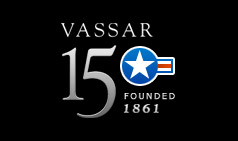Department and Program Histories
Professor Lucy Maynard Salmon’s (1853-1927) command to her history students to “go to the source” still resounds at Vassar today as we celebrate the college’s Sesquicentennial.
Over the past year members of the faculty, many working with enthusiastic students, have been investigating when and how current areas of study in the college have emerged and evolved within our 150-year-old curriculum. These essays about Vassar’s academic departments and interdisciplinary programs, which are being added to this site as they reach completion, are varied in focus and approach. They reflect many individual points of view as well as the multiplicity of a curriculum which emphasizes interdisciplinary opportunities and allows today’s students to select among forty-nine majors. Students in the 1860s (who could choose a Classical or a Scientific concentration) may have had fewer and less diverse course options, but they were seriously and perhaps even more broadly instructed. Every student was required to take classes in Latin, Mathematics, English Language and Literature, Geography, Chemistry, Logic, Physiology, and Philosophy, while other courses could be selected in additional areas of the arts, sciences and languages.
Readers perusing these accounts may well be amazed at the boldness, enterprise and generosity of Vassar’s founders, not only in establishing a college for women in 1861, but also in providing it with the best and most up-to-date instruction and the most sophisticated and costly equipment available at the time, including an observatory with a 12-inch refractor telescope and a gallery with a permanent collection of original works of art. Delayed by the Civil War until 1865, the opening of Vassar’s doors (widened after a century to admit men in the Fall of 1969) marked the beginning of a long pedagogical, architectural, and technological evolution which has continued to expand students’ opportunities to learn in and beyond the classroom: to discover new areas of study and to pursue advanced research in areas of special interest. Simultaneously, our curriculum has flexibly responded to changing times, incorporating new areas of knowledge and ways of thinking as members of the faculty, often working together, have sought the liveliest ways of engaging student response and of honing their analytic and writing skills.
Having seized upon this period of celebration as yet another opportunity for learning, we invite current and former students and members of the faculty and college community to share our excitement in discovering the history of teaching and learning at Vassar. We hope that these accounts, composed in honor of a special year in the college’s life, will also inspire others in years ahead to add to a growing legacy for the future by sharing information and images relating to their academic experiences here, either as students or as instructors.
Focusing on the intellectual life of the college, then and now, these essays are intended to inform and entertain today’s readers while providing useful perspectives to assist in curricular planning for the future. Vassar’s boundaries have never been limited to the world within its gates, so reaching into the past during a birthday year in which we are also looking ahead highlights the quest for expanding awareness that has marked our mission from the very start.
Susan Donahue Kuretsky ’63
Professor of Art on the Sarah Gibson Blanding Chair and Sesquicentennial Co-chair
(assisted on the Histories Project by Nicole Weindling ’10, Sophia Alexandrov ’11, and Maria Emilia Fernandez ’13)
November, 2010
Acknowledgements:
Boundless thanks are offered to Vassar’s historians, Professor Emerita Elizabeth A. Daniels (’41) and Professor Emeritus Colton Johnson, whose extensive research on the history of the college and whose availability for consultation have contributed so much to the preparation of these essays. Special thanks also go to Ronald Patkus and Dean Rogers in the Special Collections sector of the Main Library for generous assistance to faculty and students seeking archival and photographic materials.
Two sources (others are cited within individual essays) deserve special mention here: the extensive online Vassar Encyclopedia Project (directed by Elizabeth A. Daniels ’41) and Karilyn B. Strickand, (’05) and Marian Thomas (’04), An Administrative History of Vassar College 1861-2003, eds. Ronald Patkus and Elizabeth Daniels, Poughkeepsie, 2004.
